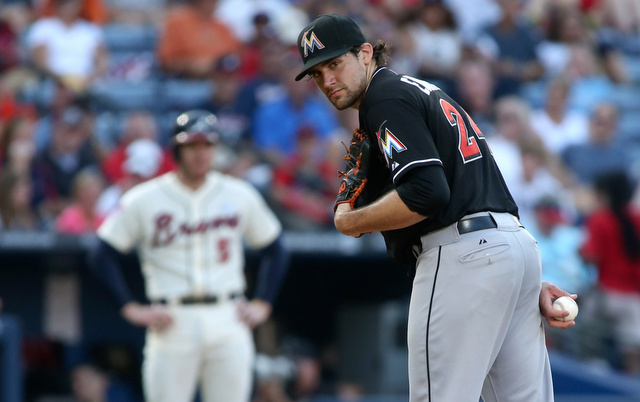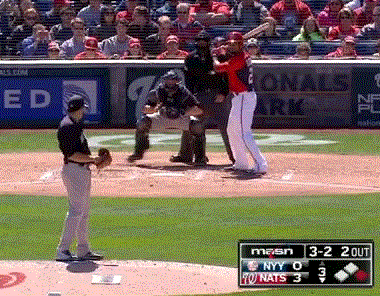
NEW YORK -- Rather than invest nine figures in a proven ace like Max Scherzer or Jon Lester this past offseason, the Yankees opted to beef up their rotation with a younger pitcher whose best years are (theoretically) still ahead of him. They swung a five-player trade with the Marlins in December to acquire 25-year-old Nathan Eovaldi. He has a huge fastball ... and he also led the NL with 223 hits allowed in 2014.
Despite being so young -- Eovaldi is younger than both 2014 Rookies of the Year -- Eovaldi has already pitched in parts of four MLB seasons and has 460 career innings under his belt. He's still learning how to harness his power stuff, but there is one aspect of pitching he seems to have already mastered: shutting down the running game.
"We work on it a lot. A lot of (pitcher's fielding practice) and holding runners. Just changing the look and stuff," said Eovaldi on Wednesday. "You don't want to get too consistent and let them catch on with what you're doing and just take a free bag. But yeah, runner on first, I've always slide stepped. I'm always quick to the plate, plus I throw hard, so my times to the plate are usually pretty fast."
Clearly, the Yankees focused on Eovaldi's skillset and not his results (6-14, 4.37 ERA in 2014). They see a guy who had the fourth highest average fastball velocity among qualifed starters last season (95.4 mph), and someone who has steadily cut his walk rate from 13.7 percent of batters faced in 2011 to 5.0 percent of batters faced in 2014. As far as Fielding Independent Pitching (FIP) goes, the pre-2015 trend doesn't get more encouraging than this:
Source: FanGraphs -- Nathan Eovaldi
Eovaldi is still a work in progress though, and the Yankees know this. They're hoping veteran pitching coach Larry Rothschild can turn Eovaldi's impressive natural gifts into high-end baseball results, sort of like he did with Brandon McCarthy in the second half last season.
From 2013-14, Eovaldi allowed only two stolen bases in 306 innings. Four others were caught stealing, so opposing teams attempted just six steals with Eovaldi on the mound the last two seasons. No right-handed pitcher in baseball allowed stolen base attempts at a lower rate than Eovaldi. Not even close. Heck, only one left-handed pitcher allowed steal attempts that infrequently.
| 2013-14: Best Pitchers at Limiting The Running Game | ||
| Pitcher | Innings per SB Attempt | SB Attempts / SB Opportunity |
|---|---|---|
| LHP Hyun-Jin Ryu | 57.3 | 1.21% |
| RHP Nathan Eovaldi | 50.9 | 1.24% |
| RHP Adam Wainwright | 33.4 | 2.28% |
| RHP Chris Tillman | 31.8 | 2.20% |
| LHP Mark Buehrle | 31.2 | 1.99% |
| RHP Bartolo Colon | 28.0 | 2.47% |
| RHP R.A. Dickey | 27.5 | 2.66% |
| RHP Doug Fister | 26.6 | 2.51% |
| RHP Hisashi Iwakuma | 26.5 | 3.33% |
| MLB Average | 11.5 | 5.72% |
Those nine pitchers were the nine best at shutting down the running game the last two seasons according to the two measures in the table. The two leaderboards begin to diverge after those nine names. (A stolen base opportunity is defined as a plate appearance with a runner on first or second base with the next base open, according to Baseball-Reference.)
Over the last two seasons runners attempted to steal once every 50.9 innings against Eovaldi. Wainwright is a distant second among right-handers at 33.4 innings, and he has the advantage of throwing to Yadier Molina, the best throwing catcher in baseball. Waino may be great at holding runners, though there's no doubt Molina's presence helps. Teams rarely try to steal against Yadi. Tillman, the third best righty at holding runnings, was able to throw 51 percent of his innings to Matt Wieters from 2013-14, another one of baseball's elite throwing catchers.
Eovaldi didn't have the luxury of throwing to a Molina or Wieters. Far from it. He managed to shut the running down while pitching to a group of catchers that was collectively below average at throwing out attempted base-stealers.
| 2013-14: Nathan Eovaldi's catchers | ||
| Catcher | Innings with Eovaldi | Overall CS% |
|---|---|---|
| Jeff Mathis | 138.0 | 33% |
| Jarrod Saltamacchia | 124.1 | 20% |
| Rob Brantly | 36.2 | 24% |
| Koyie Hill | 7.0 | 14% |
| MLB Average | 27% | |
Left-handed pitchers have an obvious advantage when combating the running game. They can stare at the runner on first and they can throw over without turning their body. Righties can't do that, so they have to vary their times before delivering the ball and be quick to the plate. An effective slide step is crucial.
Generally speaking, a pitcher is about average if he can deliver the ball to the plate in 1.30 seconds from the stretch. That's from the start of his motion to when the ball gets to home plate. A time of 1.25 seconds is above-average and considered pretty efficient. The catcher will have a chance to throw out most base-stealers with that pace.
In his final spring start this past Saturday, Eovaldi averaged 1.21 seconds to the plate with his slide step pitches according my unofficial measurements. His quickest time was 1.16 seconds. Eovaldi doesn't look particularly quick to the plate because of his arm action, though I suppose we could consider that a feature, not a bug.

Shutting down the running game is about more than limiting stolen bases, however. Holding runners at first also keeps the double play in the order. Eovaldi had a slightly below average 43.1 percent ground ball rate with men on base from 2013-14 (MLB average is 44.7 percent) yet was able to got a double play in 12 percent of his double play opportunities according to Baseball-Reference, a tick better than the 11 percent league average.
Holding runners also helps limit how often runners will go first-to-third on a single, or score from first on a double. It might not seem like much, but having to shorten your lead by half a step because the pitcher is paying close attention can make a big difference. It's the oldest cliche in the book but it is absolutely true -- baseball is a game of inches, and Eovaldi steals inches from base-runners.
Now, holding runners is a great skill to have, but there is such a thing as paying too much attention to the runner at first and not focusing on the hitter, who can do the most damage in any given plate appearance. Eovaldi admitted he ran into trouble earlier in his career because his attention was on the runner, not the guy at the plate.
"I've gotten into trouble plenty of times where I'm trying to stop the runner -- holding him too much -- and not focused on executing the pitch," he said. "That's like the two biggest things with holding runners on. (I realized) you want to be quick enough but also make a good pitch to the plate. That's the number one priority, throw strikes and working ahead, and getting that out."
Cynics will say Eovaldi learned how to hold runners so well because he's had plenty of men on base over the years (career 1.38 WHIP), and that could very well be true. His job first and foremost is to get the hitter out and he still has some work to do in that phase of the game. But holding runners is an important secondary skill and almost no one compares to Eovaldi at shutting down the opponent's running game, right-handed or left-handed. He's the master right now.
"I don't want to let guys take free bases. If they're going to steal, I want to give me catcher enough time to have an opportunity to throw them out," added Eovaldi. "I take pride in it."





















